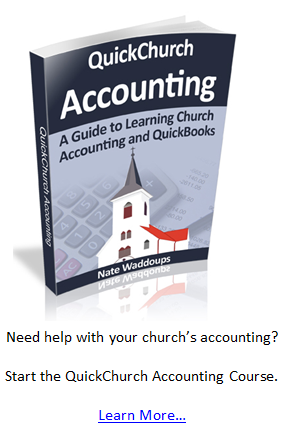We are in the third of our series of articles dealing with how churches handle contributions. Our first article gave general rules for contributions as they relate to churches. Please see general reporting requirements for the full article. Our second article dealt with non-cash donations. Please see the non-cash contribution requirements for the full article.
This current article will focus on how churches, donors, and the IRS handle contributions of stock and IRAs given to churches.
Contributions of Stock:
A contribution of stock is just another form of a non-cash contribution. As mentioned in earlier articles, the donor is responsible for obtaining the fair market value of the donation for his income tax return. Additionally, the donor is responsible to obtain from the church a written receipt for any single cash or non-cash donation in excess of $250. In no circumstances will the church put the value of the stock on the contribution receipt. They will, however, describe the stock on the statement.
Housekeeping Details:
If a donor wishes to donate stock to a church, how should they go about doing this? The donation will start by the donor sending the stock certificates and a signed stock power to the church. Alternately, the stock can be transferred directly from the donor’s brokerage account into the church’s brokerage account if they have one.
Is it better for the Donor to Contribute the Stock to the Church or to Sell the Stock first and then donate the Proceeds?
Like most everything in the tax world, the answer depends on the donor’s individual situation.
The donor may have stock that has appreciated in value since it was purchased. If he donates it to the church, he avoids having to pay the capital gains tax on the sale plus he can also take a charitable donation for the fair market value of the stock. It is almost like getting a double benefit for the donor! In turn, if the donor would realize a loss on the sale of stock, he would probably benefit by selling the stock first, claiming the loss on his tax return, and then donating the proceeds to the church.
Stock owned by the donor is classified as a capital asset and is taxed depending on how long the stock has been held. If the stock is held for more than 1 year and then sold, long term capital gains tax rates apply to any gain on sale. If the stock is held for 1 year or less, the gain is taxed at the ordinary income tax rates of the taxpayer. For 2011, the long-term capital gains tax rate is 15%. This is due to increase to 20% in 2012.
Lets take a look at some comprehensive examples of a donor who is thinking about either contributing his stock to his church or selling the stock first and then donating the proceeds to the church. The facts are as follows:
-
- Donor purchased 10 shares of XYZ stock on 1/1/2000 for $300.
- Donor contributes the 10 shares of stock to his church on 11/1/2011.
- The fair market value of the 10 shares of stock on 11/1/2011 is $1,200.
- The long term capital gains tax rate for 2011 is 15%
- The long term capital gains tax rate for 2013 is 20%
- Example 1: Donor sells the stock for $1,200 on 11/1/2011 and donates the proceeds to the church:
- The gain on the sale of the stock is $900 ($1,200 sales price less $300 cost basis)
- The gain on the sale is taxed at the long-term capital gains rate. The donor pays $135 ($900 * 15%) tax on the gain on his income tax return.
- The donor makes a cash donation of $1,065 ($1,200 proceeds less $135 tax paid)
- The church enters the cash donation on the donor’s contribution record and supplies the donor with a written receipt for the donation of $1,065.
- The donor takes a charitable income tax deduction of $1,065.
- The church records a debit to “Cash” and a credit to “Contribution Revenue” in the amount of $1,065.
- Example 2: Donor sells the stock for $1,200 on 1/1/2013 and donates the proceeds to the church:
- The gain on the sale of the stock is still $900.
- Since the sale is made in 2013, the donor is subject to the long term capital gains tax rate projected to be in effect for 2013. As of the writing of this article, that rate is 20%. The tax on the gain is $180. ($900 * 20%)
- The donor makes a cash donation of $1,020. ($1,200 proceeds less $180 tax paid)
- The rest of example 1 applies here except the amount is changed from $1,065 to $1,020. Notice that waiting to make the sale in the new year results in the payment of $45 more tax for the donor and receipt of $45 less donation for the church
- Example 3: Donor contributes the stock to the church on 11/1/2011
- Since the stock is being donated and not sold, the donor does not need to report or pay any tax on the capital gains.
- The church will provide the donor with a receipt that provides a description of the stock “10 shares of XYZ stock” but will not include a monetary value on the receipt. This is because the donor is responsible for determining the fair market value of the donation, not the church. See the non-cash donation article for more details on determining fair market value of non cash donations.
- The church should record the stock donation on their books at fair market value as of the date of donation. In our example, this is $1,200. The church would make an accounting entry to debit “Investments - Stocks” and credit “Contribution Revenue” for $1,200.
- The church sells the stock on the same day for $1,200. The accounting entry the church should record would be a debit to “Cash” and a credit to “Investments- Stock” for $1,200.
- In order for the donor to take an income tax deduction on their tax return, they must complete IRS Form 8283. In our example, the amount for the taxpayer would be $1,200. This amount would be recorded in Section A of Form 8283.
- If the amount of the stock in our example were over $5,000, the donor would need to complete Section B of Form 8283. If this section is completed, the donor will ask the church to sign the Section called “Donee Acknowledgment”. See IRS Form 8283 "Noncash Charitable Contributions" for more details.
- Additionally, if IRS Form 8283 Section B 1 is completed because the donation is over $5,000, the church must complete IRS Form 8282 if the donated property is sold within 3 years of receipt. See IRS Form 8282 "Donee Information Return". This form must be mailed to the IRS within 125 days after the date of sale.
- Notice in this example how the donor does not pay tax on the appreciation of the stock and receives a donation for the appreciated amount. In turn, the church receives the full benefit of the appreciated stock. In our example, if the church later sold the stock for a gain, it wouldn’t matter because the church does not pay tax.
Charitable Contributions Received from IRAs
In 2006, a tax situation was created that favored individuals age 70 ½ or older to make qualified charitable distributions from their otherwise taxable individual retirement accounts (IRAs). The provision expired at the end of 2009. In 2010, as part of the 2010 Tax Relief Act, the provision was extended through December 31, 2011. As of the writing of this article, it is not known if this benefit will extend to the end of 2012.
This benefit works a little differently in that it does not result in an income tax deduction but results in an exclusion from gross income. To understand this better, lets take a closer look at it.
Individuals under the age of 70 ½ by the end of the year and who have taxable income are eligible to open a Traditional IRA. A Traditional IRA may be tax deductible or non-tax deductible on the individual’s tax return depending on a number of different factors. See IRS Publication 590 "Individual Retirement Arrangements" for more information. When the person reaches age 70 ½, they must start taking money out of the account. The amount they have to take out each year is prescribed by the IRS and is called the required minimum distribution. This distribution is taxable income to the individual and is included on their tax return. (Notice how the traditional IRA differs from the ROTH IRA. The traditional IRA receives tax deductions when the money is contributed to the fund but is taxed when the money is taken out. The ROTH IRA has no tax breaks when the money is contributed to the fund, but is not taxed when the money is taken out).
The current tax law due to expire 12/31/2011, states that individuals age 70 ½ or older may distribute up to $100,000 per tax year directly from their Traditional IRA account to a church without having to include the distribution in their gross income. This results in the payment of less income tax. The distribution to the church can also satisfy the required minimum distribution limits. In order to claim this tax benefit, the individual must obtain the proper contribution receipt from the church, even though the individual is not taking an income tax deduction. Generally, the church will receive a check from the administrator of the IRA. The church should record this money received on the individual’s contribution statement with a description of IRA proceeds included. If the church received shares in the IRA, then the contribution statement should be handled the same as the receipt of stock.
As always, please consult your CPA because you may have tax situations that are unique. Additionally, IRS rules are subject to change.
Icon Systems appreciates bringing these resources to churches hosted by Church Accounting Software Guide. The last one will deal with the receipt of automobiles, boats, and other vehicles by churches.


Speak Your Mind
You must be logged in to post a comment.